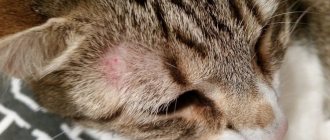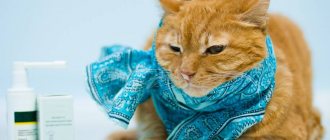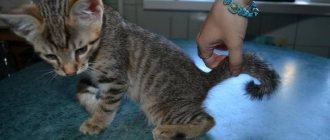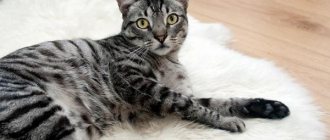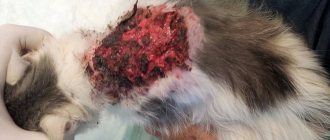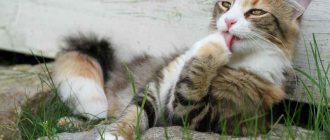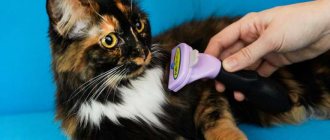Ringworm: symptoms and treatment at home
Ringworm does not manifest itself immediately; the incubation period can last up to three months. The first signs of the disease are the appearance of round spots without hair. At first the spots are small in size, but gradually they increase in size and occupy more and more surface area on the cat’s body.
Initially, lichen appears on the ears, face, tail and paws of the animal. With ringworm, the affected areas of the skin are covered with gray, oily scales.
The disease occurs in different forms. The easiest of them is superficial, the more complex and dangerous is the deep form of ringworm. It most often affects kittens, older cats and animals with weak immunity.
The third form of the disease is atypical. With this form of ringworm, isolated areas without hair form on the cat's body. What makes recognizing the disease difficult is that ringworm of this form can be confused with ordinary abrasions or abrasions.
The superficial form of lichen is also difficult to recognize, since upon external examination, especially if the cat is fluffy, the spots are not always easy to notice. Is there a cure for lichen in cats? Yes, and below we will look at how to do this.
Treatment
If your pet is at home almost all the time, this does not mean that the fungus is not scary for him.
Rather, on the contrary, in such cats the disease develops faster and is more difficult. How to cure cat ringworm? It is recommended to isolate a sick cat or limit its presence on a bed, sofa, or chair as much as possible. This must be done because lichen can spread to humans.
The first thing you need to do to treat a sick pet is to cut the hair near the affected area and treat the spots with brilliant green or iodine.
How to treat tinea versicolor?
Weeping eczema is a disease caused by a malfunction of the cat's immune system.
Weeping eczema does not develop as a result of exposure to fungi; it is provoked by the following factors:
- External - the presence of parasites (ticks, fleas), exposure to detergents, lack of proper hygiene.
- Internal - disturbances in the functioning of the nervous system, hormonal imbalances, stress.
Symptoms
Symptoms of weeping eczema are painless red spots on the pet's skin with an increase in body temperature in areas of inflammation. Then such spots will be covered with dense blisters with exudative fluid.
As a result of properly selected treatment, such blisters can resolve, and if left untreated, they can open and become infected, resulting in the formation of ulcers.
After the ulcers rupture, the skin in the area of inflammation becomes moist. In turn, the correct approach to treatment and access of air to the inflammation contributes to the fact that the area of weeping lichen will quickly become covered with a crust, which will soon fall off in the form of scales.
Treatment
It is worth recognizing that weeping eczema in a cat is quite difficult to treat, so achieving a complete recovery can be difficult. However, the health of your four-legged friend is worth any effort!
So, what should you do if your cat has shingles? It is very important to consult a veterinarian before starting treatment, who will determine the cause of the development of this disease.
General recommendations in the treatment of weeping lichen may include the use of antiseptic and astringent agents that can significantly improve the cat’s skin in areas of inflammation. The following ointments have proven effective in the treatment of lichen: salicylic, ichthyol, sulfuric, tar, YaM ointment.
Signs of infection
The first signs of this infectious disease may appear in the form of red spots that the cat scratches intensely and often. After some time, the red spots become covered with blisters containing exudative fluid.
If treatment is not started on time, the blisters burst when scratched, become infected and form ulcers.
The fur in these places begins to fall out partially or completely. If your pet has long hair, then the bald patches are difficult to notice. But attentive owners will notice the cat’s restless behavior: she refuses to eat, gets angry and constantly itches.
Treatment of pityriasis rosea
At the initial stage, pityriasis rosea in cats looks like a pink spot with clear boundaries and constant peeling. Constant itching causes great discomfort to the cat. In most cases, after a few days the pink spot will be covered with a dry crust.
Such spots tend to spread to other parts of the pet’s body.
Treatment
Since the development of pityriasis rosea is often associated with a decline in the cat's immune strength, treatment is focused on strengthening and maintaining the cat's immunity. Fortunately, this type of lichen does not require special treatment.
Often, all that is needed is to provide the cat with adequate nutrition, which would include a complex of microelements and vitamins. During the treatment of pink lichen, it is strictly forbidden to wash the animal. In addition, it is important to completely protect the cat from sunlight.
Over the course of 1-2 months, this type of lichen goes away on its own.
Briefly about lichen
The initial invisible period when we fearlessly contact our cats is dangerous.
Therefore, it would be necessary to examine her coat more often in order to notice the problem even at the first stage: hair loss outside of molting periods (due to damage to the hair follicles) and the appearance of rashes and redness on the skin.
Within a few days, starting from the face and limbs, dandruff and round patches of alopecia appear, which eventually become crusty and itchy.
And then (if left untreated!) the areas become inflamed and increasingly enlarged, and in the advanced form, the lymphatic system and brain are affected, blindness occurs and then... death occurs. But things go so horribly and far only for poor homeless people who have absolutely no one to help...
How to cure pityriasis versicolor?
Pityriasis versicolor is extremely contagious for both humans and other animals. It often begins as a small oval spot with a color that can range from pale yellow and pink to brown.
Subsequently, the spots quickly spread throughout the cat's body, merging together.
Treatment
Treatment of pityriasis versicolor requires a competent and responsible approach, therefore, if the first symptoms of the disease appear, you must urgently contact a veterinarian.
In the treatment of this type of lichen in cats, products containing enilconazole are used, for example, Imaverol. In severe cases, treatment of the cat with Lime Sulfur is prescribed.
Treat with home remedies
An alternative method of treating lichen in cats is the use of proven methods of traditional medicine. Despite the fact that they are less expensive, their effectiveness has been proven only in the early stages of the disease.
Their use is justified if there is no veterinary pharmacy nearby or there is no money to purchase pharmacological drugs.
How to treat lichen in cats at home? Consider popular recipes:
- Iodine. Treat the affected areas and the area around them with iodine or brilliant green twice a day.
- A mixture of olive oil and lemon juice. Mix the ingredients in equal proportions and heat slightly. Dip tampons into the medicinal mixture and apply to the affected areas 4 times a day.
- Celandine. Rub freshly squeezed celandine juice into the affected areas 4-5 times a day.
How to treat lichen in a cat at the initial stage of development of the disease
When choosing treatment, the veterinarian pays attention to the severity of the fungal infection, the state of the animal’s immunity, and the size of the areas affected by the disease. Thanks to a comprehensive approach, it is possible to select the appropriate method and eliminate the cause of the development of skin pathology. At the first signs of the disease, effective external preparations for lichen in cats and therapeutic and prophylactic vaccines can be prescribed. Learn more about the two methods.
Ringworm vaccine for cats
To treat animals, including those with trichophytosis, antifungal vaccines are used, which aggravate the infection and promote the rapid removal of crusts from the surface of microtic lesions. Vaccinations are contraindicated for pregnant and lactating cats and kittens under 2 months of age. Before giving the injection, deworming must be done 10 days before (even for a kitten). Vaccine prices are affordable, since many are produced in Russia. Popular drugs that attack fungi in a short time:
- Vakderm;
- Polivac;
- Microderm;
- immunostimulants Ribotan, Anandin.
Sulfur ointment for microsporia
How to treat lichen fungus in cats? Use sulfur ointment - a local remedy for microsporia in people and pets. The drug is available in glass jars of 25 g and 1 kg. Price in pharmacies – from 30 rubles. The active ingredient of the ointment is sulfur, which, after absorption, forms hydrogen sulfide, sulfur dioxide. Under the influence of these substances, antimicrobial activity is achieved and the epidermis is restored. How to treat ringworm in cats with ointment? You just need to smear a little product on the affected areas and around them by 2-4 cm 1-2 times a day. Treatment – at least a week.
- How to quickly raise blood pressure at home
- Sorrel soup: recipes with photos
- What are the benefits of persimmon?
Getting rid of the disease in a generalized form
In the presence of multiple lesions of the skin, it should be recognized that the disease has developed into a generalized form.
At the same time, the affected areas make up more than half of the cat’s body, which means there is a risk of developing a secondary infection. That is why the generalized form of lichen requires very serious therapy - in addition to the use of ointments, sprays, and vaccinations, the doctor must prescribe antifungal medications and oral agents.
What are the best products to use?
After diagnosing a generalized form of the disease, the following medications for cats are prescribed for lichen:
- Itraconazole . A drug that suppresses the vital activity of most types of fungi. Since Itraconazole is toxic, the dosage must be adjusted by a veterinarian.
- Griseofulvin is a tablet that is aimed at suppressing fungi. This remedy helps the cat’s body replace the affected tissues with new ones as soon as possible. The drug is prescribed in combination with rubbing alcohol, iodine, as well as ointments for lichen. It is convenient to mix the product into animal feed.
Why does the body need iodine?
The trace element iodine is an essential component of the cat's thyroid hormones. It promotes the growth and development of the kitten, regulates metabolic processes in the cat’s body, helps in the treatment of inflammatory processes in the gastrointestinal tract and various types of infections.
The cat's body produces about 10% of iodine, the pet gets the remaining 90% from food. Meat, milk, sea fish, eggs, and vegetables are rich in iodine. A lack of microelement causes dysfunction of the thyroid gland and the development of Graves' disease, hair loss, and weight gain. With a lack of hormones, hypothyroidism occurs - metabolic processes are disrupted, cell division slows down, and reproductive function is seriously affected. An excess of iodine in the body causes so-called acquired hyperthyroidism.
In the animal's body, iodine performs many functions:
- regulates the speed of biochemical processes;
- takes part in energy exchange;
- corrects the cat's temperature balance;
- affects water-electrolyte, protein and fat metabolism;
- promotes the absorption of vitamins;
- induces an increase in oxygen consumption by body tissues;
- promotes tissue differentiation, growth and development of the cat.
In short, your pet needs iodine for an active and healthy life. Therefore, if there is a microelement deficiency in the body, veterinarians prescribe iodine-containing drugs.
Prevention of iodine deficiency in cats
For hypothyroidism, veterinarians prescribe a special diet for cats. Many manufacturers add it to food as part of natural ingredients (for example, seaweed meal) or in the form of synthesized compounds, thereby replenishing the required amount in the cat’s body.
Prevention
To keep your cat healthy, you will need to follow these guidelines:
- When purchasing a new pet, it is necessary to thoroughly examine it.
- Regularly thoroughly clean furniture with a weak bleach solution, since many types of microorganisms and fungi are sensitive to it.
- Constantly clean and disinfect your cat's habitat.
- It is advisable to protect the cat from walking outside.
- Keep your pet away from other cats.
It is worth noting that for the most effective treatment of lichen in cats, it should be prescribed by a veterinarian after a thorough examination of the animal.
